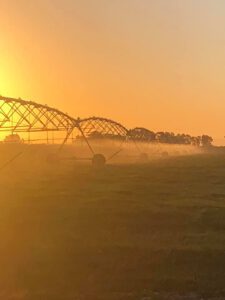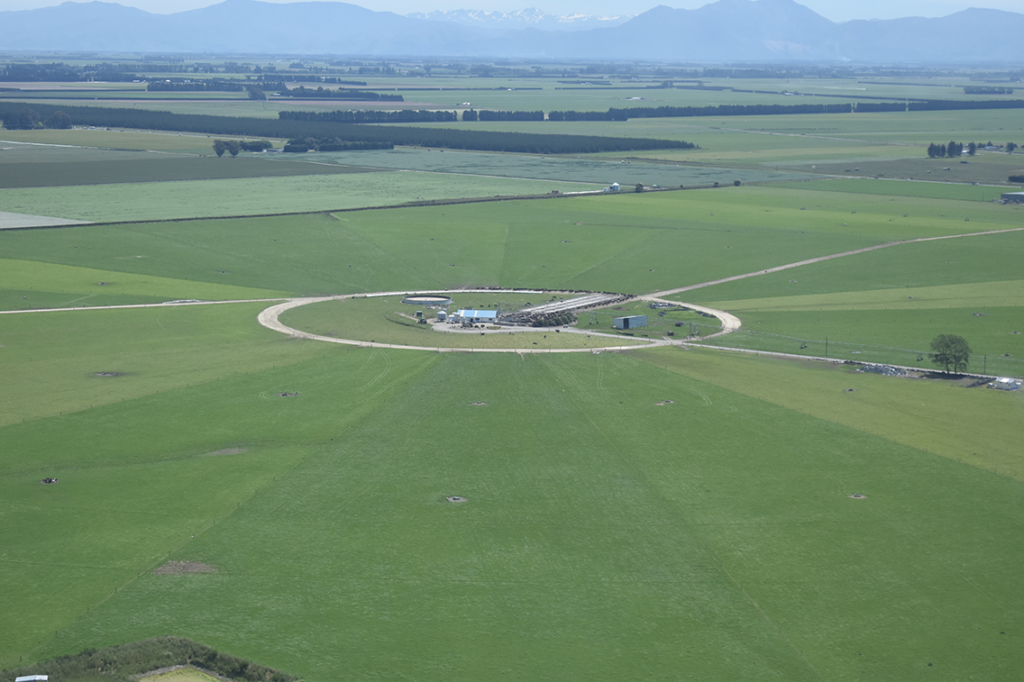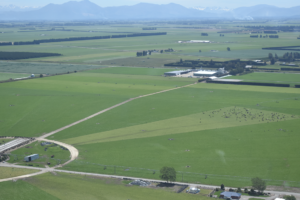The Canterbury Plains area of New Zealand’s South Island is a rich area of surface-water-irrigated dairy and crop farming. Its large schemes, similar to American irrigation districts, draw water from the alpine rivers and convey it via pressurized pipes and open channels to the region’s highly efficient farms.
John Nicholls is a dairy farmer as well as the chair of MHV Water, one of New Zealand’s largest irrigation schemes; he is also a director of a number of other large businesses that provide services into the agricultural industry. In this interview with Irrigation Leader Managing Editor Joshua Dill, Mr. Nicholls explains why New Zealand dairy farmers are so efficient and highlights the distinctive features that set New Zealand’s irrigated agriculture apart from that of the United States.
Joshua Dill: Please tell us about your background and how you came to be in your current position.
John Nicholls: It wasn’t until my late 20s that I started dairy farming. I had graduated from university, traveled the world and worked in a number of professional occupations, including sales and marketing, but I hadn’t found my niche. Dairy farming was that niche.
I quickly learned that the most important thing about business is employing the right people and having the right team around you. My wife and I struggled the first couple years; she had to go back to work to support the business while we had a young family. Once we got the right people around us and the right management team, our business grew reasonably quickly.
We were reasonably aggressive—we bought and sold property in the Wairarapa, in the southern part of New Zealand’s North Island. The area has quite a harsh climate to farm in, with wet winters and dry summers, and our property had no irrigation. We quickly learned that we needed irrigation to build the resilience of our revenue. We purchased an irrigated property, and it opened my eyes to the possibilities irrigation provided. We leased another irrigated property and spent another 10 years in the North Island before deciding to sell and head south to Canterbury. We sold the majority of our business on the North Island, shifted our family to the South Island, and purchased two irrigated dairy farms in an area where, at that stage, there was an abundance of water and an abundance of opportunity. From that point, again employing great people, we began building our business. Today, we own 6 dairy farms with 5,000 cows and employ just under 35 people.

When I was first elected to the board of Mayfield Hinds Irrigation Limited (MHIL), it was solely a water supply company. Within a reasonably short period, I was elected chair and we started to develop the company. Today, it is a multifaceted service operation that not only delivers water but also manages environmental consents for its farmer-shareholders and engages in education and advocacy. Again, I knew we needed the right people, and we recruited a new chief executive officer, Mel Brooks, who shared our vision. About that time, MHIL merged with a neighboring irrigation scheme, Valetta Irrigation Limited, to form MHV Water, which is now New Zealand’s largest irrigation company. We see ourselves as an intergenerational cooperative, with our shareholders at heart but with a wider community view as well.
As chair of MHV Water, I have always had a strong interest in the irrigation company’s activities and strategy and in how it would continue to remain relevant. I had exposure to other cooperative governance structures and wanted to be part of guiding MHV Water through what I expected would be a period of considerable change.
I am also a chair and a director on a number of other boards. My governance roles have grown to the stage where my time on an actual dairy farm is quite limited—I spend maybe 1 day a week on farm. The majority of my time is spent on governance and looking beyond the horizon to the future.
There are some big issues coming down the road for our farmers. On farm, there is an increasing focus on environmental sustainability, specifically the management of nutrient losses to water and greenhouse gas emissions to the atmosphere. More broadly, we need to consider how our industry could be disrupted and ensure we have the capacity to understand and adapt to future developments so that that our shareholders’ farming businesses continue to be profitable. MHV Water, in various forms, has been around for 80 years, and we want to make sure we’re here for the next 80 years, delivering value to our shareholders.
Joshua Dill: Would you tell us a little more about MHV Water?
John Nicholls: We’re located in Mid Canterbury, an area of 350,000 hectares (850,000 acres) bounded by two rivers. We have 206 farmer-shareholders, and we deliver water via a network of 320 kilometers (200 miles) of open races and 100 kilometers (60 miles) of pressurized pipes. We take our water supply from the Rangitata Diversion Race (RDR), of which we are a shareholder. The building of the RDR began as a work project during the Great Depression. It takes water across the top of the Canterbury Plains to supply irrigation, and the unused water is used for hydropower generation. Our farmers use the water we deliver to irrigate 58,000 hectares (140,000 acres) of highly productive land in the Hinds/Hekeao Plains of Mid Canterbury. Approximately 60 percent of MHV shareholders are dairy farmers; 20 percent are dairy support, or farmers who grow feed and provide winter grazing for the cows; 15 percent are cropping farmers, who grow corn, wheat and alfalfa; and 5 percent raise sheep and deer.
Joshua Dill: Would you tell me about the efficiency of dairy farming in New Zealand?

John Nicholls: The animals live outside 365 days a year, and production follows a seasonal profile, with the entire herd calving in spring and milking through until the end of fall. The cows are almost wholly pasture fed, and we aim to align the growth of our pasture to milk production so as to limit any cutting and carrying of feed. We do still use some feed supplements when needed, and in the South Island where it’s a bit cooler, the cows are fed a forage crop during the winter. Cows typically spend 2 months at winter grazing and come back to the dairy/milking platform for the next 10 months.
The majority of our irrigation systems are incredibly efficient pivot systems. All these systems are audited by irrigation companies to make sure they have at least 80 percent distribution efficiency, with a desire to reach 85 percent efficiency.
Joshua Dill: Irrigation Leader is going to be leading a tour to New Zealand next year, which is going to include visits to the Canterbury Plains area and a dairy farm. What distinctive things about New Zealand farming should participants look out for?
John Nicholls: You’re going to be very welcome in our part of our world.
I would suggest looking at our pasture-feed system. It’s not too common around the world. Water storage on farm is quite common. We have storage within our scheme and need to build more storage to improve our resilience as we move forward. It might also be interesting to see how we run our systems, using moisture meters and other technology to try to match irrigation to pasture demand.
Another thing to look at would be the variance between open-channel schemes, which are probably more similar to U.S. irrigation districts, and piped infrastructure. We are currently upgrading our open races, and by the time of your visit we will have completed the installation of Rubicon gates for automated delivery and control. Our long-term objective is to be able to deliver on-demand water in an open-race scheme as if with the flip of a switch.
Our pipe schemes also differ from the ones U.S. visitors may be familiar with, simply because they are gravity pressurized. The Canterbury Plains area is actually quite steep, with a fall of about 1:100, meaning that the natural fall of the land is sufficient to pressurize our piped water. Our biggest challenge is typically designing sufficient pressure relief into the system so that the pressure doesn’t build up too high.
Our cropping systems are slightly different too. Our farms don’t have the scale of U.S. cropping farmers and typically grow a mix of grain and seed crops as well as running livestock (either supporting the dairy industry or lamb finishing for meat production).
The Canterbury Plains has seen significant changes in farming over the last 20 years. That change has attracted progressive farmers who have built some incredibly successful businesses. I think you will find it fascinating to hear their thoughts about where they are today and what they think farming will look like in 5–10 years.
Joshua Dill: Would you tell us about the regulatory legislation that is expected to be passed in the next year or so in New Zealand and how that will affect farmers?
John Nicholls: In Canterbury, we’re already under a reasonably robust regulatory system. By 2035, we have to reduce losses of nutrients from our soils by 36 percent. That’s a big ask. The first milestone requires reductions of 15 percent by 2025. To achieve this, we need to improve on-farm practices around water and fertilizer use. We are focusing considerable effort on education, and we will need to continue to do that to ensure that farmers all understand their responsibilities and what they need to do. Ultimately, it could mean a change in fertilizer use and a change in water usage. Our current government is talking about a 10 percent reduction in livestock methane emissions by 2030. We need to understand the science of what this means, what it looks like, and how we adapt.
Some farmers and shareholders are facing a huge number of headwinds and a lack of confidence in our sector. It’s challenging, but when you look at the farming sector as a whole, over the last 2–3 years, our dairy and meat sectors have actually enjoyed some of their highest and most consistent returns. Profitability in the farming sector is incredibly strong; we just have underlying statutory costs coming at us.
There should be confidence in our market, but because of those headwinds, there isn’t. Our current government seems hostile to agriculture, even though it is the backbone of the New Zealand economy. I’m sure the tour participants will be surprised, since a lot of your states are incredibly supportive of agriculture and what it means for their economies.
Joshua Dill: Tell us about your vision for the future for irrigated farming and dairy farming in New Zealand.

John Nicholls: I’m incredibly excited about it. For irrigation, I want to maintain and improve the resilience and reliability that our system already has.
We need to maintain the flexibility within our irrigation system to adapt to the needs of our farmers. Currently, most of our on-farm systems are set up to grow grass or cereal crops and can apply 5 millimeters (3/16 inch) of water per day. In the future, there could be other crops that need double that amount of water but for only half the number of days. I’m conscious that we don’t want our systems to be locked into our current practice; they need the capability to evolve as we change what we grow.
From a dairy farming point of view, I’m incredibly excited about the future. The world supply of dairy is flat and will potentially start to decline. We just need our industry to be incredibly focused on adding value to milk so that they we can provide the highest milk price back to the farmers.
In Canterbury, I would love to see further consolidation across the irrigation schemes to ensure that we have consistency in how we apply our regulatory requirements. We already have a constructive relationship with our local regulator, Environment Canterbury (ECan), and with consolidation, I think we could agree to some high-level outcomes and become a lot more self-managed around what we do to achieve those outcomes. That’s going to take time—it could be 10 years—but ultimately, there could be one entity that manages all surface water, groundwater, and nutrient allocations and reports back to ECan. At the same time, we are a cost-recovery business, and we’ve got to make sure that we run an efficient business that returns value to our shareholders as we navigate these disruptions.
John Nicholls is chair of MHV Water and a managing director of Rylib Group. For more about MHV, visit www.mhvwater.nz.
